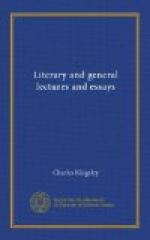Thus, at least, we can explain that rigidity, which Mr. Ruskin tells us, “is a special element of Gothic architecture. Greek and Egyptian buildings,” he says—and I should have added, Roman building also, in proportion to their age, i.e. to the amount of the Roman elements in them—“stand for the most part by their own weight and mass, one stone passively incumbent on another: but in the Gothic vaults and traceries there is a stiffness analogous to that of the bones of a limb, or fibres of a tree; an elastic tension and communication of force from part to part; and also a studious expression of this throughout every part of the building.” In a word, Gothic vaulting and tracery have been studiously made like to boughs of trees. Were those boughs present to the mind of the architect? Or is the coincidence merely fortuitous? You know already how I should answer. The cusped arch, too, was it actually not intended to imitate vegetation? Mr. Ruskin seems to think so. He says that it is merely the special application to the arch of the great ornamental system of foliation, which, “whether simple as in the cusped arch, or complicated as in tracery, arose out of the love of leafage. Not that the form of the arch is intended to imitate a leaf, “but to be invested with the same characters of beauty which the designer had discovered in the leaf.” Now I differ from Mr. Ruskin with extreme hesitation. I agree that the cusped arch is not meant to imitate a leaf. I think with Mr. Ruskin, that it was probably first adopted on account of its superior strength; and that it afterwards took the form of a bough. But I cannot as yet believe that it was not at last intended to imitate a bough; a bough of a very common form, and one in which “active rigidity” is peculiarly shown. I mean a bough which has forked. If the lower fork has died off, for want of light, we obtain something like the simply cusped arch. If it be still living--but short and stunted in comparison with the higher fork—we obtain, it seems to me, something like the foliated cusp; both likenesses being near enough to those of common objects to make it possible that those objects may have suggested them. And thus, more and more boldly, the medieval architect learnt to copy boughs, stems, and at last, the whole effect, as far always as stone would allow, of a combination of rock and tree, of grot and grove.
So he formed his minsters, as I believe, upon the model of those leafy minsters in which he walked to meditate, amid the aisles which God, not man, has built. He sent their columns aloft like the boles of ancient trees. He wreathed their capitals, sometimes their very shafts, with flowers and creeping shoots. He threw their arches out, and interwove the groinings of their vaults, like the bough-roofage overhead. He decked with foliage and fruit the bosses above and the corbels below. He sent up out of those corbels upright shafts along the walls,




